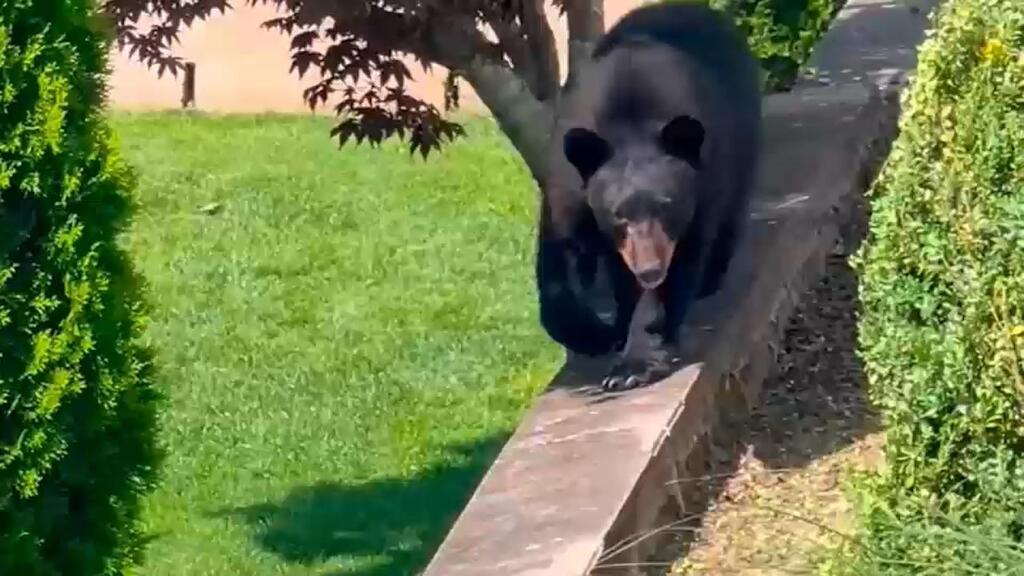A black bear wandering through backyards in New York's West Harrison, a quiet suburban enclave just half an hour from Manhattan, became the unlikely center of a heated public debate this week—one that now pits local police against state wildlife officials and stirs emotions among residents of this predominantly Jewish community in New York’s Westchester County.
The 150-pound animal, first spotted near one of the town's main avenues on Monday morning, reappeared later that day near a central intersection, an area lined with tightly spaced homes and manicured lawns. Witnesses say the bear moved slowly between yards, occasionally climbing fences and at one point taking refuge in a tree. Many neighbors, while startled, described the bear as docile and visibly frightened.
1 View gallery


The black bear wandering through backyards in New York's West Harrison
(Photo: Sccreenshot)
“He was just scared,” said Douglas Puff, a local resident whose children were home at the time. “We heard the gunshot. Then we heard the poor thing moaning. It really upset the kids.”
The bear’s rare appearance drew a crowd, with some residents snapping photos and videos, while others expressed concern for safety. Harrison police arrived alongside an officer from the New York State Department of Environmental Conservation (DEC), which advised that, unless the bear posed a clear threat, it should be left alone to retreat into nearby wooded areas.
But sometime that afternoon, as officers attempted to monitor and contain the bear’s movements, a Harrison police officer fired a shot. The bear fell from the tree and died shortly after. A town-hired animal removal service later disposed of the body.
The police department promptly released a statement saying it had exhausted all non-lethal options and made the “difficult decision to humanely euthanize the bear in the interest of public safety.” Officials added that neither the DEC nor county services were able to provide tranquilizers or trapping equipment at the scene.
That version of events, however, was immediately contradicted by the DEC, which said its officers had determined the bear did not pose an imminent threat and had access to reasonable escape routes. “The bear should have been left alone to leave the area on its own,” the agency said.
Wildlife experts were among the most vocal critics. “This did not need to happen,” said Brigette Dix of the Cottontail Cottage Wildlife Refuge. “The bear was literally napping in someone’s yard.”
Stephanie Gomez, also from the refuge, called the killing “disheartening and upsetting,” especially given that help may have been available. A recording shared with local news reportedly captured a wildlife expert offering assistance with tranquilization shortly before the shooting occurred.
Even within the local community, reactions were mixed. Some defended the officers' decision. “If you have to, you have to. You don’t want someone getting hurt,” said resident John Abadir. Others emphasized that the bear’s behavior was not aggressive and that the event could have been handled differently with better planning and training.
Harrison police now say they will evaluate new protocols, including cross-training officers in animal tranquilization and reassessing their coordination with state agencies.
The incident has sparked discussion far beyond West Harrison, tapping into broader concerns about suburban sprawl and human encroachment on wildlife habitats. Some residents noted that ongoing redevelopment in the neighborhood - once semi-rural - is driving animals like bears closer to human populations. “It was bound to happen,” said one longtime resident. “We’ve taken over so much of the land.”
Founded in 1696 and home to a growing and diverse population of nearly 30,000, Harrison includes several neighborhoods, among them Purchase and West Harrison. Though historically known for its affluent enclaves and corporate campuses, the area is also notable for its sizable Jewish community, many of whom reside in West Harrison itself. The area’s synagogue, kosher delis and cultural institutions serve as a hub for Jewish life in Westchester County.
Get the Ynetnews app on your smartphone: Google Play: https://bit.ly/4eJ37pE | Apple App Store: https://bit.ly/3ZL7iNv
Over the years, Harrison has also been home to a number of prominent figures. Famed aviator Amelia Earhart lived in a house off Locust Avenue - today named Amelia Earhart Lane - during her marriage to publisher George Putnam. A memorial in a small town park commemorates her historic solo flight across the Atlantic. Fashion designer Kenneth Cole, known for his eponymous brand, was also born and raised in Harrison.
In a town where sightings of raccoons and deer are common - but bears decidedly are not - the death of this bear has become more than just a local wildlife story. For many, it is a symbol of how unprepared even well-resourced suburbs can be when urban expansion collides with nature.
As town officials promise reviews and residents post memorials on local forums, one question remains unresolved: could the bear have been spared if cooler heads - and better equipment - had prevailed?


